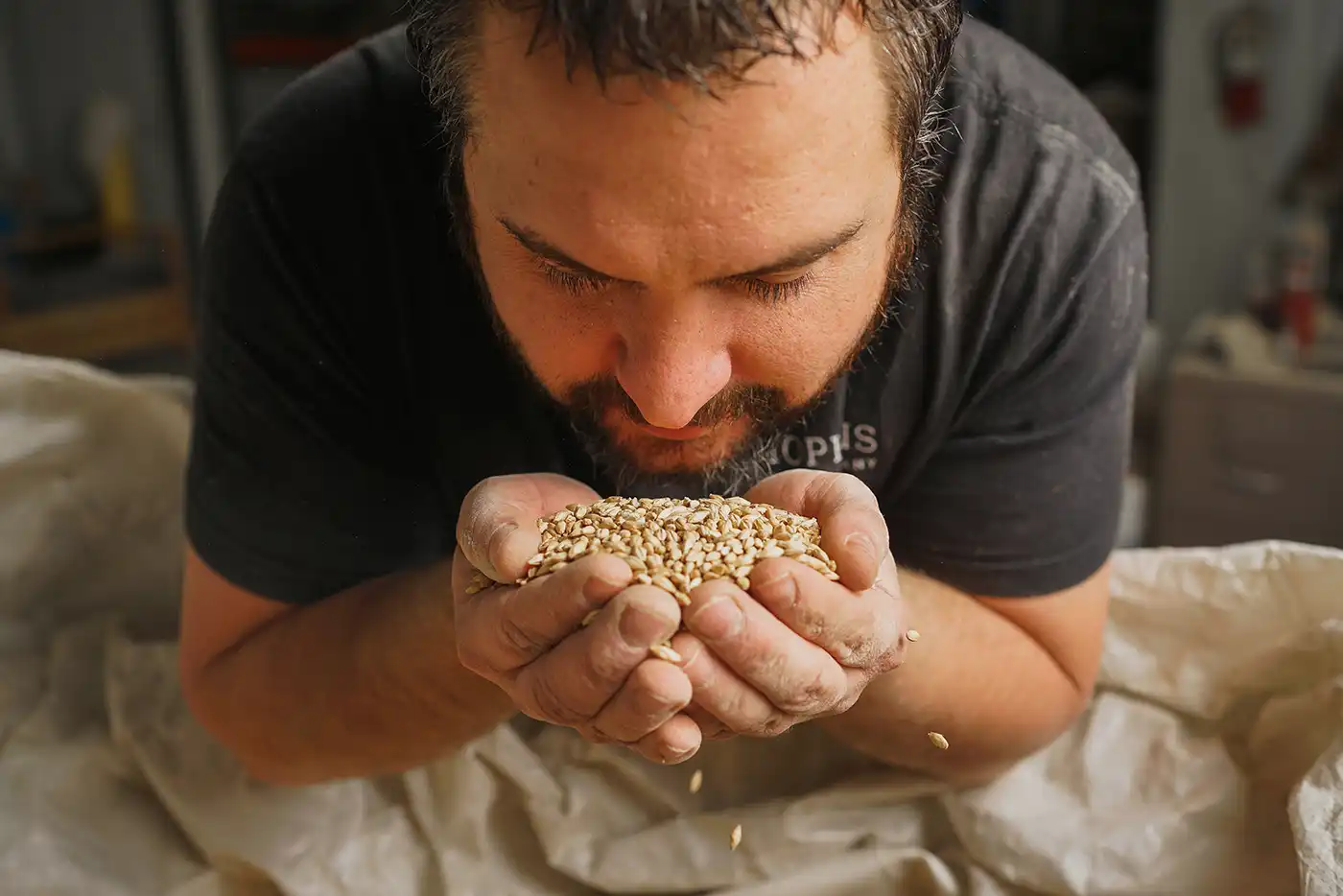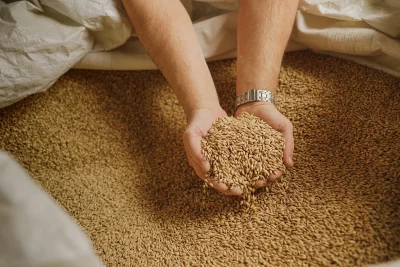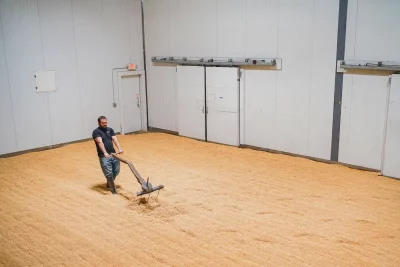
Solstice Malt is Keeping Old-World Malting Techniques Alive
Beer & Spirits
“Historically, every town had its own brewery, but every town also had its own malt house,” says James Weed, the owner and sole full-time employee of Solstice Malt. “That’s where you get Vienna malt or Pilsner malt or Munich malt.” These malts, and the beer that resulted from them, became so popular that they are still recreated around the world today.
I wouldn’t be surprised if “Utah malt” is the next big malt on the horizon. Solstice Malt is taking the state’s breweries and distilleries by storm, and it doesn’t get more hyper-local than this. “I work with almost exclusively Utah grains,” Weed says. “I get my rye out of Collinston, my wheat comes out of Nephi and I get my oats and corn from West Jordan. Barley comes from lots of different places, but this year, I mostly get it out of Price.”
While Solstice Malt will accommodate all kinds of special requests, Weed typically won’t malt grains that aren’t grown in Utah. “We’ve had requests for rice for rice beers, but nobody’s growing that here,” he says. “The mantra of brewing is ‘drink local,’ right? So we’ve kept everything local, and I’ve had super warm reception from all the brewers and distillers.”

With a past as a stockbroker and investment advisor, Weed’s journey to becoming a maltster began with an interest in homebrewing. His knowledge of economics and the importance of locality drives his commitment to local sourcing. When he attended a party where several head brewers were hanging out, drinking each other’s beers and sharing advice, Weed knew he was ready to pivot his career. “It was the opposite of finance, where it’s cutthroat,” he says. “I liked the community aspect.”
“The mantra of brewing is ‘drink local,’ right? So we’ve kept everything local, and I’ve had super warm reception from all the brewers and distillers.”
Weed wanted to be more involved in the homebrewing process, so he started growing his own hops. But when he began malting his own barley, he found it was difficult to find resources. “It wasn’t easy in a small-batch, 20–50 pound scenario,” Weed says. “I went online trying to find tips and tricks, and there’s nothing out there. The big malt houses have owned everything since the ’70s, and they keep everything proprietary.”
For an industry that makes very little information available, malting is an integral part of the brewing process. During germination, enzymes break down starches in the grain to help produce a plant. Malting stops the enzymes from attacking the starch so brewers can use it in the brewing process, activating the enzymes and breaking down starches into sugar. The yeast can then eat the sugar to create alcohol. The color, flavor and foam properties of the final beer product are also dependent on the type of malt used to create it.
“I knew I couldn’t compete with big malt houses price-wise, so I had to create a premium product. That’s the reason I went with floor malting, even though it is really labor intensive.”

At the Solstice Malt production facility in west Salt Lake City, Weed soaks 8,000-pound batches of grains in 65-barrel tanks, which mimics a spring thaw. Then comes a special germination process: The grains are shoveled onto the floor by hand. Weed rakes them every 10–12 hours for about five days. “This is an old style of malting that is still used in some Scottish distilleries,” he says. “I knew I couldn’t compete with big malt houses price-wise, so I had to create a premium product. That’s the reason I went with floor malting, even though it is really labor intensive.”
The grains are then transported into a kiln, which is operated at different temperatures to create different colors of malt. “Nobody builds equipment in my size, so I kind of had to create it. It used to be the walk-in freezer at Lehi High School, or so I was told,” Weed says about his kiln, which is the most technologically advanced piece of equipment he uses. “I’ve got multiple humidity and temperature sensors on there. It’s a pretty smart system, and I get pretty tight on the kilning style. It does integrate some new technology into the kilning phase, but I like to keep it as old-world style as I can.”
Once dried down, Weed vacuums out the grains and drops them into a debearder, which agitates the rootlets free from the grain over a screen. The product is then lifted into a grain cleaner (Weed’s is solid oak and bears an inscription from 1947). Finally, 50-pound bags are loaded and shipped off to breweries and distilleries. The entire process takes about one week.
“I’ve got multiple humidity and temperature sensors on there. It’s a pretty smart system, and I get pretty tight on the kilning style. It does integrate some new technology into the kilning phase, but I like to keep it as old-world style as I can.”
Weed strives to run a zero-waste operation and offers a reusable bag program, which he estimates has saved thousands of bags from the landfill. Even the byproducts of the malting process have a use. “Those rootlets that we separate are almost 25% protein, and it becomes animal feed,” Weed says. “I give that back to the farmer, and maybe they throw me a few cuts of meat by the end of the year. That’s reciprocity.”
About 90% of Solstice Malt customers are brewers or distillers who use the malt for beer or whiskey, with the remaining small fraction using it for a baking product called diastatic malt, which is used by savvy bakers to boost yeast activity for a faster rise and adds sweetness and color. The majority of Utah-local breweries—such as Bewilder, Proper, Kiitos, Shades, Desert Edge, Prodigy, Hopkins, Salt Flats and more—use Solstice Malt, and Weed keeps a “shrine” of Utah-made products that feature his malts in his warehouse.

Because he’s working in small batches, Weed is able to work with brewers to experiment with special grains such as blue corn and Kernza perennial wheat. In the summer, he takes advantage of 100-degree days by using his own version of the historic wind-drying process. For this, Weed runs air through the kiln and allows the natural heat of the summer air to dry the malt for just one special batch per year.
“Brewers are always looking for a new beer or something new. It’s awesome that [brewers in Utah] feel like they can work directly with their maltster.”
“If a brewer wants to try it, I’m willing to do it,” Weed says. “I’m nimble enough that I can try different kinds of grains, whereas a big malt house can’t devote 300 tons to a special project, right? Brewers are always looking for a new beer or something new. It’s awesome that [brewers in Utah] feel like they can work directly with their maltster.”
With a growing number of breweries and distilleries popping up in Utah, Weed works hard to manage the demand. These days, he’s pretty much operating at capacity. “The next step goes big. It goes from 8,000-pound batches to 22,000-pound batches,” Weed says, “and that’s just a lot for one guy.”
“That’s another beautiful thing about the industry—people want to be a part of it. People will spend money to go on malt house tours in Scotland. Here, they get to be part of the story … It’s cool to taste your efforts when you go out to the brewery.”
To keep up with orders, he will often enlist the help of volunteers by posting on local Facebook pages for whiskey lovers or homebrewers. “Homebrewers will come to help shovel and [in return] they get a bag of malt,” Weed says. “That’s another beautiful thing about the industry—people want to be a part of it. People will spend money to go on malt house tours in Scotland. Here, they get to be part of the story … It’s cool to taste your efforts when you go out to the brewery.”
Learn more about Solstice Malt by visiting solsticemalt.com or by following the business on Instagram @solstice_malt.
Read more about local beer and cider:
Rio Connelly’s Inaugural Cider Release at Scion Cider Bar
Kiitos Brewing’s Big Gay Ale
